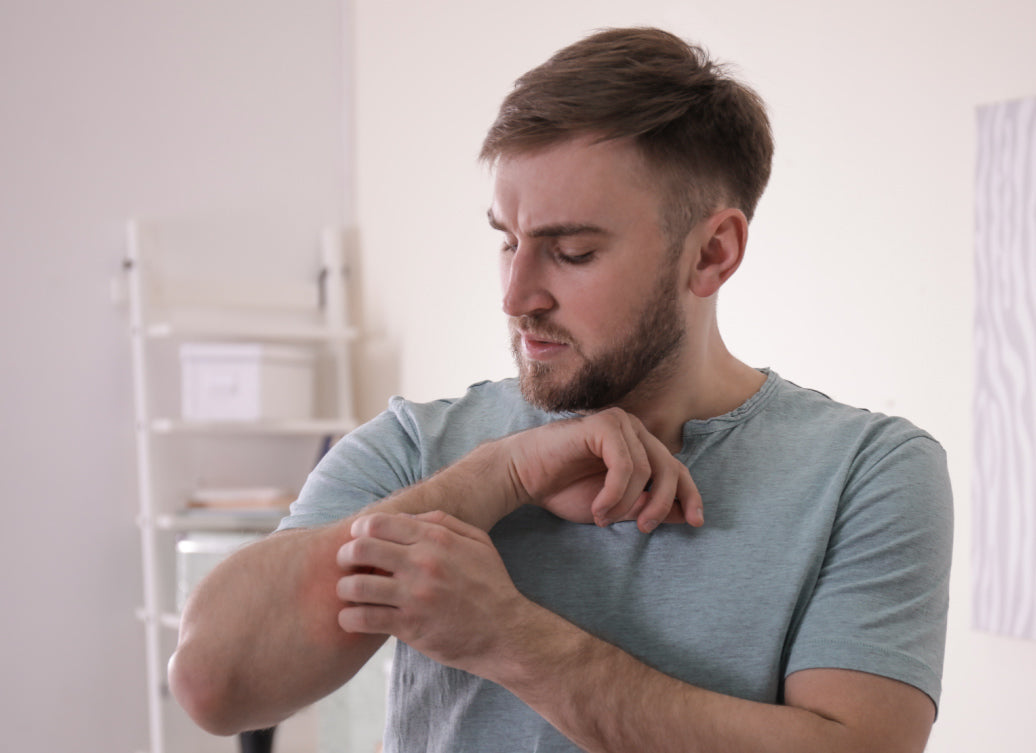Polymorphic light eruption (PMLE) is a complicated condition, characterised by an abnormal sensitivity to sunlight. It’s not completely understood how people develop PMLE, but there seems to be a combination of factors involved. Is one of those factors the medication you’re taking? Let’s take a closer look.
In previous blogs we’ve looked at how severe it can get ( Is Polymorphic Light Eruption Serious?) and whether it can be inherited (Is Polymorphic Light Eruption Genetic?); in this article we ask whether medications can cause sun sensitivity.
It’s the UV and UVA in sunlight which cause the reaction: the histamine release and subsequent inflammation triggered by the body when light hits skin is meant to be protective, but becomes a problem when it’s an over-reaction to something as normal as sunshine.
So why do some people have that dysfunctional response, and others not? It’s a tricky question! PMLE has been shown to run in families, which means that a predisposition towards sun sensitivity is part of what can add up to an outbreak of itchy, spotty or blistered rashes when skin is exposed to sunlight. There’s also an environmental component, as those more prone to PMLE are affected at particular times of year (ie the first bright days of spring or summer, or a holiday somewhere sunny) and in particular countries (regions of the world which have colder, duller winters)..
But there are other things that can cause the body to react in an extreme way to light, with similar spotty, bumpy or blistered rashes as PMLE. However, these aren’t the same as PMLE; polymorphic light eruption is a specific kind of light sensitivity, one that is all about an extra sensitivity to sunlight that some people are born with, and which is exacerbated by circumstance and environment.
What other things can cause photosensitivity?
There are a few different categories of light rash:
Other chronic conditions
Certain other conditions as well as PMLE can cause the skin to be affected by sunlight: lupus and rosacea are both inflammatory conditions which manifest in photosensitive rashes.
Solar urticaria
In many ways very similar to PMLE but considerably rarer, solar urticaria is an allergic reaction that causes hives on the skin. These raised welts can be triggered almost instantly by sun exposure, and can last for hours or days.
Actinic prurigo
Another sun reaction, but this one is characterised by extremely itchy and crusted-over bumps. It’s more likely than PMLE to be found in people who live in sunshine all year round.
Photoallergic reaction
This is a reaction to sunlight that’s caused by something on the skin, like cosmetics or plants. You need to have touched the substance and then had the same area of skin exposed to sunshine for it to happen. It can look like sun burn or blisters.
Medical photosensitivity
This kind of reaction to sunshine occurs after someone has eaten or taken something that causes their skin to react more dramatically when exposed to light. It’s more of a side-effect of certain medications than a condition in itself.
Drugs that can cause photosensitivity include some of the following:
- antibiotics
- antihistamines
- diuretics
- chemotherapy
- malaria treatments
- diabetic treatments
- painkillers
- antifungals
- statins
- cardiac medications
The symptoms of medically induced photosensitivity are similar to other kinds of sun reactions: burning or itching sensations, a rash of spots of blisters, swelling and inflammation, pain, darkening or reddening of the skin depending on skin colour.
The effects on the body of photosensitisers can be divided into two different types of reaction:
- Phototoxic is when the medication is activated by sunlight, and causes a reaction that makes the skin much more sensitive to sun, so the skin burns where the sun touches it.
- Photoallergic is when UV light changes the drug’s makeup, so that the body reacts to it with an inflammatory response. The resulting allergic reaction can look like eczema on parts of the skin that sunlight has touched.
In conclusion, there are many different types of photosensitivity that affect the skin! PMLE isn’t itself caused by medication, but some medications can cause a similar rash. Always ask your doctor or pharmacist about side-effects when drugs are prescribed, and take precautionary measures (like staying indoors, or wearing sunscreen and long sleeves) if photosensitivity is mentioned!
Read our blog How Is Polymorphic Light Eruption Treated? For more detailed information about ways to look after skin prone to PMLE.
Our products do not contain sunscreens! Do not apply oils or oil-based balms like Skin Salvation to exposed areas of skin in bright sunlight, as the oils can make the skin more likely to burn.
Recommended products:
Balmonds Daily Moisturising Cream
with shea butter and calendula
Balmonds Cooling Cream
with shea, menthol, aloe vera & lavender
